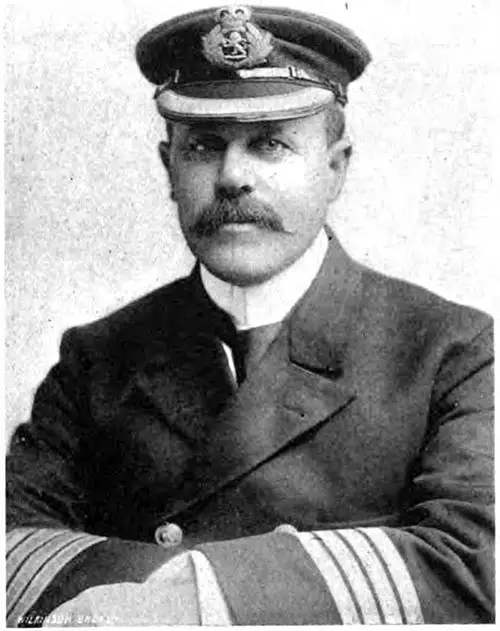Captain James Clayton Barr

Captain James Clayton Barr, Cunard Captains and Chiefs, 1905. GGA Image ID # 12efff4431
Captain James Clayton Barr, of the Saxonia, dates his career in the Cunard Line back to 1885, and his first command in the fleet to 1896, when he took over the Catalonia, in which he served during the “ trooping” seasons of the South African War. Before appointment to his present command he was, for a spell, master of the sister ship, the Ivernia, also engaged in the Boston trade.
Captain J. C. Barr, who was in command of the Catalonia whilst in South Africa, now commands the R.M.S. Lucania. (1908)
The many friends of Captain J. C. Barr will be pleased to hear of his transfer from the Lucania to the Carmania. This change has taken place to enable him to gain some experience of turbines previous to his taking over the command of the Lusitania upon Captain Watts retirement, which takes place very soon. Captain Barr is noted everywhere as being a capable and careful commander, with a very clean record. His many friends will wish him every success in his new command, with confidence that the trust reposed in him by the Cunard Company will not be misplaced. (The Nautical Magazine, Vol. LXXIX, No. 4, Apr. 1908, p. 338)
H.M.S. Carmania and the Cap Trafalgar
The memorable contest between H.M.S. Carmania and the Cap Trafalgar will rank as one the most notable naval episodes of the War. These two leviathans were equally matched, both doing duty as armed auxiliary cruisers, the Carmania a vessel Of 19,524 tons gross register, and her German antagonist of 18,710 tons. The following is an abridgement of the published report of the Admiralty:
The Carmania. sighted the Cap Trafalgar on the morning of the 14th September, 1914, off the island of Trinidad, while the German ship was taking in a supply of coal from two colliers. On the approach of the Cunarder the enemy vessels separated, and the Cap Trafalgar eventually turned and headed towards the Carmania.
The action opened at 8500 Yards by the firing of a shot from the Cunarder across the bows of the German liner which immediately replied with her starboard after gun.
The British vessel then opened with all port guns, and the firing became rapid and general, the vessels now being well within range. Most of the shots from the starboard guns of the Cap Trafalgar going high, the rigging, masts, funnels, derricks, and ventilators of the Carmania suffered considerable damage.
As the range decreased, the German machineguns became particularly dangerous, so the Cannania was turned away and the range lengthened, and she continued to manoeuvre until her starboard battery was engaged. The enemy ship was now well on fire forward and had a slight list to starboard.
The Carmcmia was struck by a shell which passed through the cabin under the forebridge and started a fire, in consequence of which the forebridge had to be abandoned, no water being available to extinguish the flames owing to the fire main having been shot through.
At this time the enemy ship was on the Carmania's starboard bow with a heavy list, and at 1.50 P.M. she sank. The brilliant engagement lasted an hour and forty minutes, and tho Carmania was struck by seventy-nine projectiles and received very considerable damage.
Practically all the communications and navigating instruments were destroyed, rendering the working of the ship difficult and uncertain. She was eventually escorted by H.M.S. Bristol and Cornwall to a safe anchorage.
The Carmania at the time of action was commanded by Captain Noel Grant, R.N., but otherwise was officered by Royal Naval Reserve men. Captain J. C. Barr, R.N.R., of the Cunard Line, who in ordinary times was the master of the Carmania, was the navigating officer, and shortly after the action he was decorated by His Majesty the King with the order of Companion of the Bath. This action will become historical as the first occasion upon which armed merchant-steamer cruisers have engaged in conflict.
Excerpt from "British Merchant Sailors Under War Conditions," in The Twentieth Century, February 1916.
BARR BRINGS CARPATHIA IN.
Cunard Captain's First Visit Here Since the War Began.
The Cunarder Carpathia arrived yesterday from Liverpool in command of Captain J.C. Barr, C.B., the Commodore of the fleet, who was the Staff Commander of the auxiliary cruiser Carmania when she fought and sank the German auxiliary cruiser Cap Trafalgar off the coast of Brazil early in the war.
After the fight the Carmania went to Gibraltar for repairs, and was later detailed for duty at the Dardanelles and in the North Sea. This is Captain Barr’s first visit to this country since the commencement of the war.
W. B. Woodrow, a Director of one of the English oil companies owning large interests in Mexico, arrived on the Carpathia with his wife, on his way to Tampico. Before leaving the steamship he requested the agent to reserve the same cabin he and his wife had occupied for the return voyage to Liverpool next Tuesday because he did not think it would be healthy to proceed to Mexico Just now.
"Barr Brings Carpathia In," in the New York Times, Sunday, 24 June 1916, P. 17, Col. 2.,
